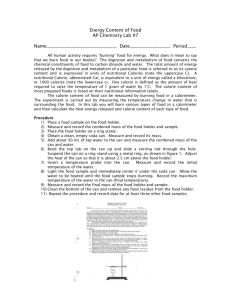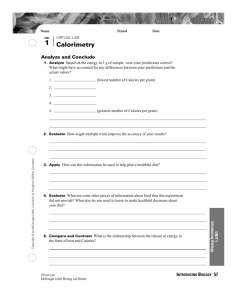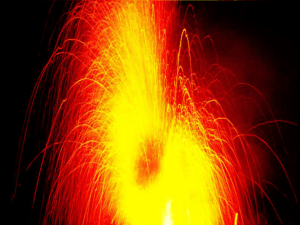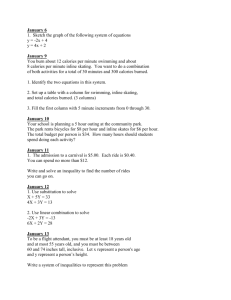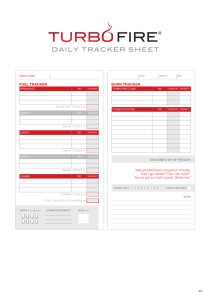Food Calorimetry Lab
advertisement
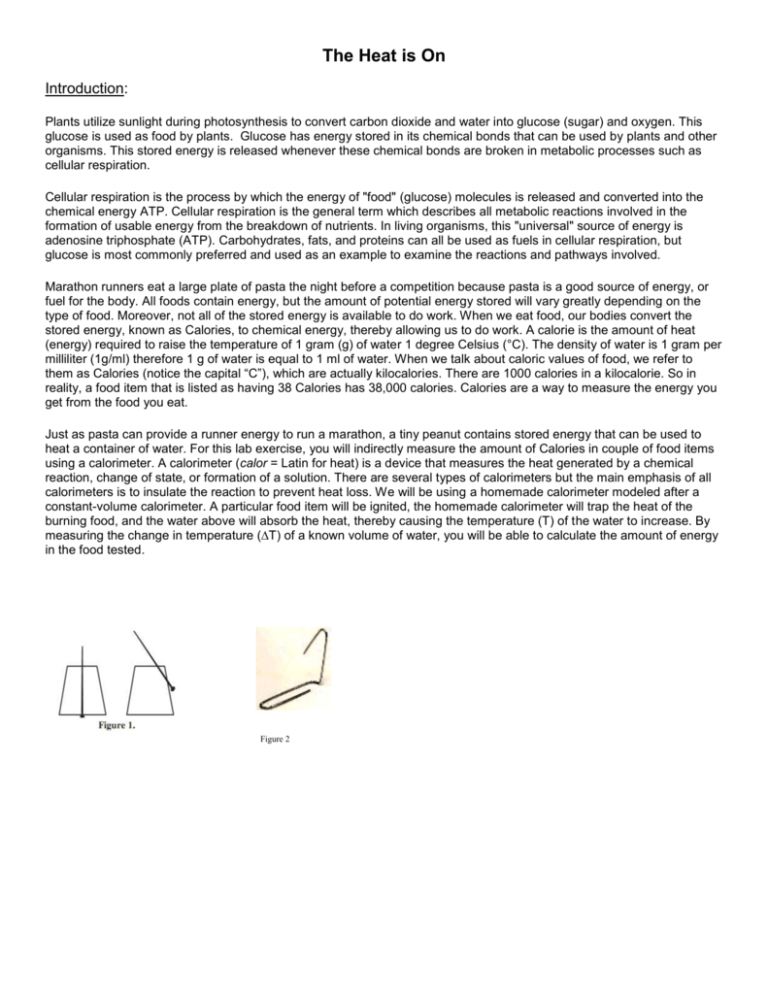
The Heat is On Introduction: Plants utilize sunlight during photosynthesis to convert carbon dioxide and water into glucose (sugar) and oxygen. This glucose is used as food by plants. Glucose has energy stored in its chemical bonds that can be used by plants and other organisms. This stored energy is released whenever these chemical bonds are broken in metabolic processes such as cellular respiration. Cellular respiration is the process by which the energy of "food" (glucose) molecules is released and converted into the chemical energy ATP. Cellular respiration is the general term which describes all metabolic reactions involved in the formation of usable energy from the breakdown of nutrients. In living organisms, this "universal" source of energy is adenosine triphosphate (ATP). Carbohydrates, fats, and proteins can all be used as fuels in cellular respiration, but glucose is most commonly preferred and used as an example to examine the reactions and pathways involved. Marathon runners eat a large plate of pasta the night before a competition because pasta is a good source of energy, or fuel for the body. All foods contain energy, but the amount of potential energy stored will vary greatly depending on the type of food. Moreover, not all of the stored energy is available to do work. When we eat food, our bodies convert the stored energy, known as Calories, to chemical energy, thereby allowing us to do work. A calorie is the amount of heat (energy) required to raise the temperature of 1 gram (g) of water 1 degree Celsius (°C). The density of water is 1 gram per milliliter (1g/ml) therefore 1 g of water is equal to 1 ml of water. When we talk about caloric values of food, we refer to them as Calories (notice the capital “C”), which are actually kilocalories. There are 1000 calories in a kilocalorie. So in reality, a food item that is listed as having 38 Calories has 38,000 calories. Calories are a way to measure the energy you get from the food you eat. Just as pasta can provide a runner energy to run a marathon, a tiny peanut contains stored energy that can be used to heat a container of water. For this lab exercise, you will indirectly measure the amount of Calories in couple of food items using a calorimeter. A calorimeter (calor = Latin for heat) is a device that measures the heat generated by a chemical reaction, change of state, or formation of a solution. There are several types of calorimeters but the main emphasis of all calorimeters is to insulate the reaction to prevent heat loss. We will be using a homemade calorimeter modeled after a constant-volume calorimeter. A particular food item will be ignited, the homemade calorimeter will trap the heat of the burning food, and the water above will absorb the heat, thereby causing the temperature (T) of the water to increase. By measuring the change in temperature (∆T) of a known volume of water, you will be able to calculate the amount of energy in the food tested. Figure 2 Background Questions: (Answer questions in complete sentences in your lab notebook.) 1. Why do plants carry out photosynthesis, but animals do not? 2. What is ATP? 3. What does the calorie content on a nutritional label mean? Why is this information on our food labels? 4. What is calorimetry? Objective: In this experiment, you will measure the amount of energy available for use from nuts, a plant product, and other foods. This process of measuring the energy stored in food is known as calorimetry. Question: (copy into lab notebook) Which foods contain the highest amount of available energy? How will different snack foods compare in their energy content? Hypothesis: PLEASE WRITE A TESTABLE HYPOTHESIS RELATED TO THE QUESTION(S) IN YOUR LAB NOTEBOOK. Materials: large paper clip OR cork/pin, oC thermometer, glass stirring rod, soft drink can calorimeter set up, mixed nuts, snacks/food, matches/lighter, water, electronic balance, pencil & paper, 50 or 100 ml graduated cylinder, calculator Procedure: 1. Set up your Food Holder. OPTION 1: Push a pin or paperclip through a cork so that the pin head is flush with the cork. If the pin is large enough, try to go through the center. If this is hard to do, try to insert the pin at an angle through the side and top of the cork. See Figure 1. OPTION 2: Bend a large size paper clip so that food can be attached and hung from the top. Seet Figure 2. Note: This setup will now be referred to as the “Food Holder.” 2. Place a food sample on the food holder. Measure and record the combined mass of the food holder and sample. 3. Using a graduated cylinder, measure and add 50.0 mL of water to an empty, clean soda can. 4. Place the soda can with water on top of the open soda can. 5. Insert a thermometer into the can. Measure and record the initial temperature of the water. 6. Center the food sample in the open soda can base and light it from the bottom (make sure it is all the way lit- this may take several seconds!). Allow the water to be heated until the food sample stops burning. Record the maximum (final) temperature of the water in the can. 7. Measure and record the final mass of the food holder and sample. 8. Clean the bottom of the can and remove any food residue from the food holder. 9. Repeat steps 1–8 three more times with three different snack food samples. Results: (cut out and paste into lab notebook once complete) FOOD #1: ALMOND/NUT FOOD #2: ______________ FOOD #3: FOOD #4: ______________ _______________ Initial Temperature (TInitial)of Water o C Final Temperature (TFinal) of Water o C ΔT = TFinal – TInitial o C Q (heat gained in calories) Food Calories (Q/1000) Initial Mass(mInitial) (food sample and holder) g Final Mass (mFinal) (food sample and holder) g Δm = mFinal – mInitial g Energy Content per Gram = Food Calories /Δm Actual Calorie Content per Gram on Package Analysis and Calculations: (show all calculations in your lab notebook) 1. Calculate change in temperature of the water by subtracting the initial water temperature from the final water temperature. Record this in the data table above. 2. Calculate the heat gained by the water using the equation below. The mass of water used is 50.0 g and the specific heat of water © is 1.0 cal/g oC. These values will give you the heat gained in calories. Place your values in the data table above. Q = mCΔT Q = heat energy m = mass of water C = specific heat of water ΔT = change in water temperature 3. Convert the heat gained from calories (calculated in #2) into food Calories (kilocalories) by dividing the answer obtained in #2 by 1000. Record the values in the data table. 4. Determine how much of the food burned (change in mass) by subtracting the final mass of the holder/food assembly from the initial mass and record the values in the data table. 5. Calculate the energy content per gram of each food sample. This is done by dividing the food calories by the change in mass of the food sample. This is a theoretical calculation based on your lab results. 6. Look at the nutrition label on the food packages (or use an internet resource) to determine the actual calorie/energy content per gram of each food sample. Questions & Conclusion: (Answer in complete sentences in your lab notebook.) 1. Where did the energy stored in the nut originally come from? Be specific. 2. During what process was this energy stored in the nut? 3. What simple sugar made by plants is a common source for energy? 4. What process in cells releases energy stored in foods? What is the energy made called? 5. Give some examples of how organisms might use this energy. 6. Why was the final mass of the nut less than the original mass of the nut? (Remember that matter cannot be destroyed in a chemical reaction.) 7. Compare the calories per gram show on each food’s nutritional label to the values you obtained in the second to last row of the Data Table. Are your values lower or higher? Why? 8. How do your food samples compare to each other in the calories per gram? Rank them from lowest to highest amount. Do these rankings match how they would rank if using the calories on the actual food labels? Please elaborate and explain. 9. Discuss all possible sources of error in this lab. 10. Explain how photosynthesis and cellular respiration are interconnected/show a cycle. Use a picture/diagram to enhance your answer.

